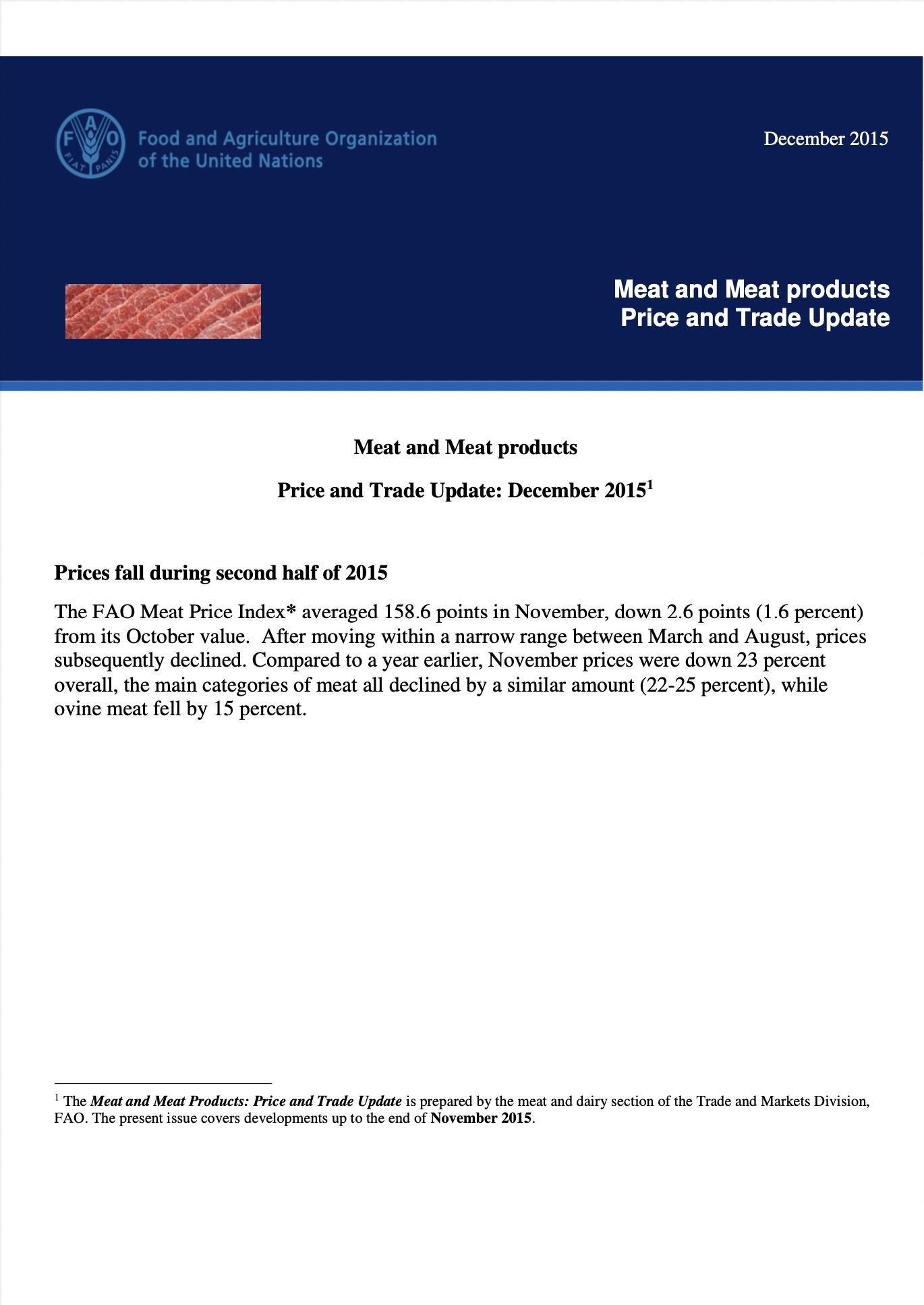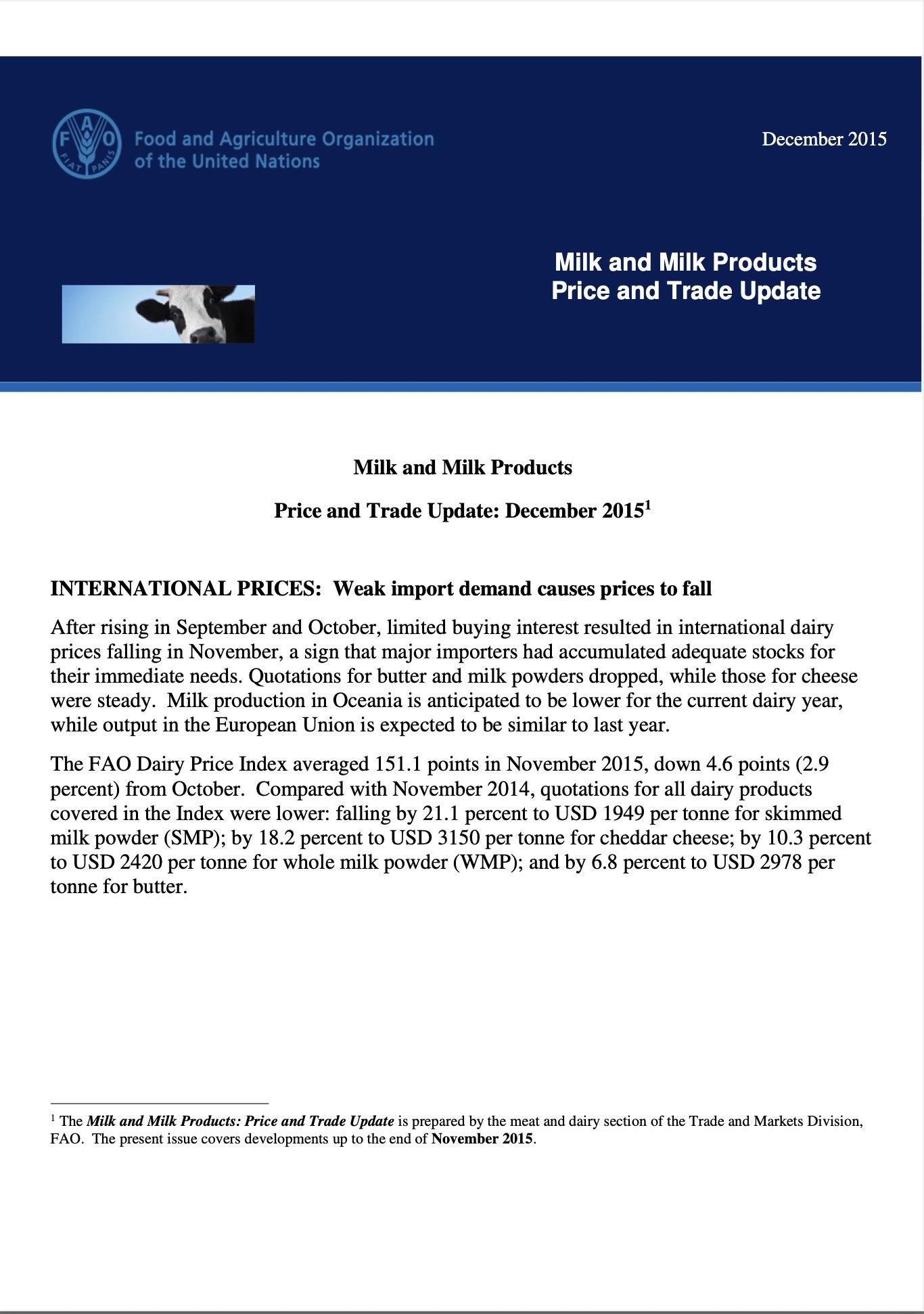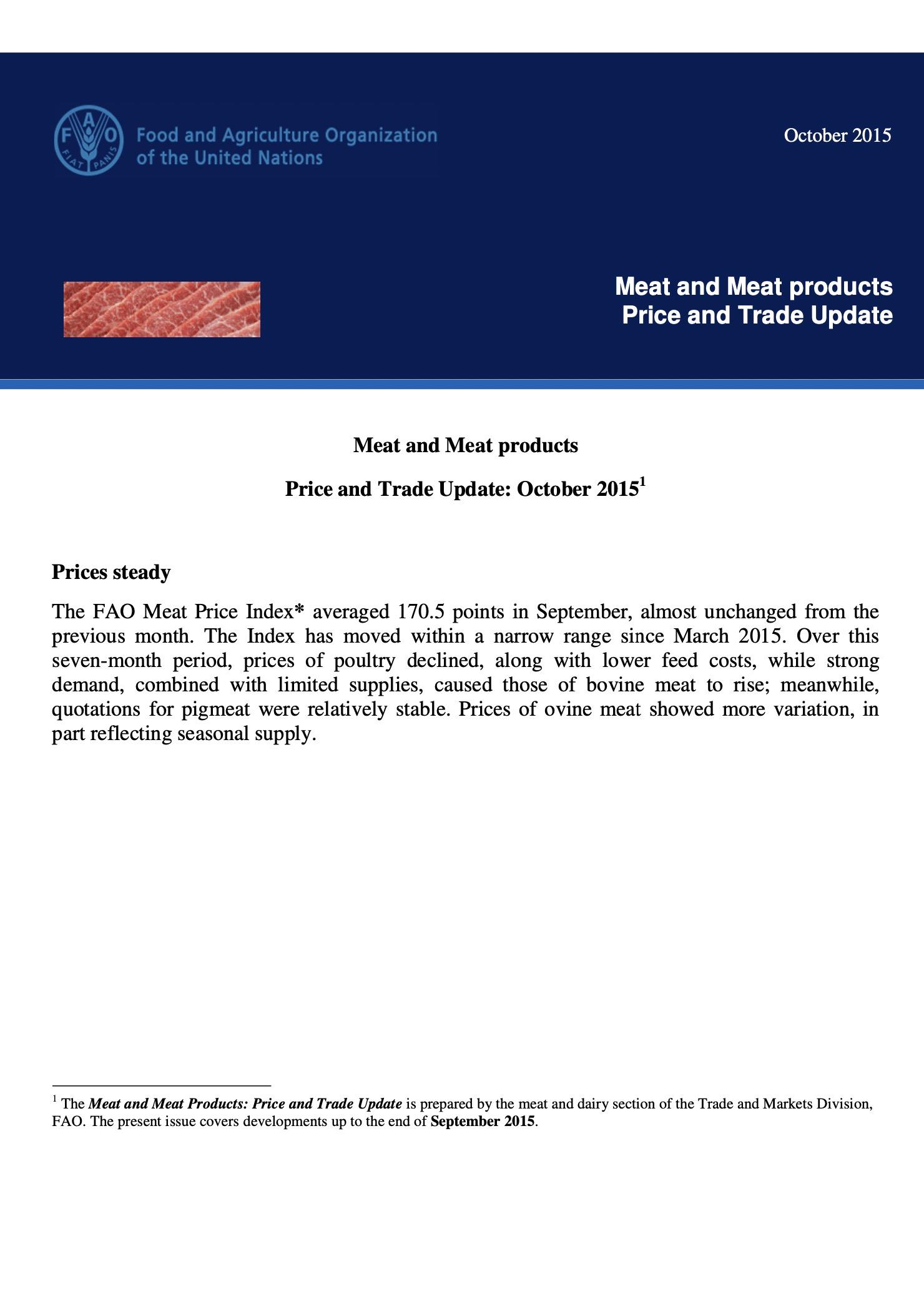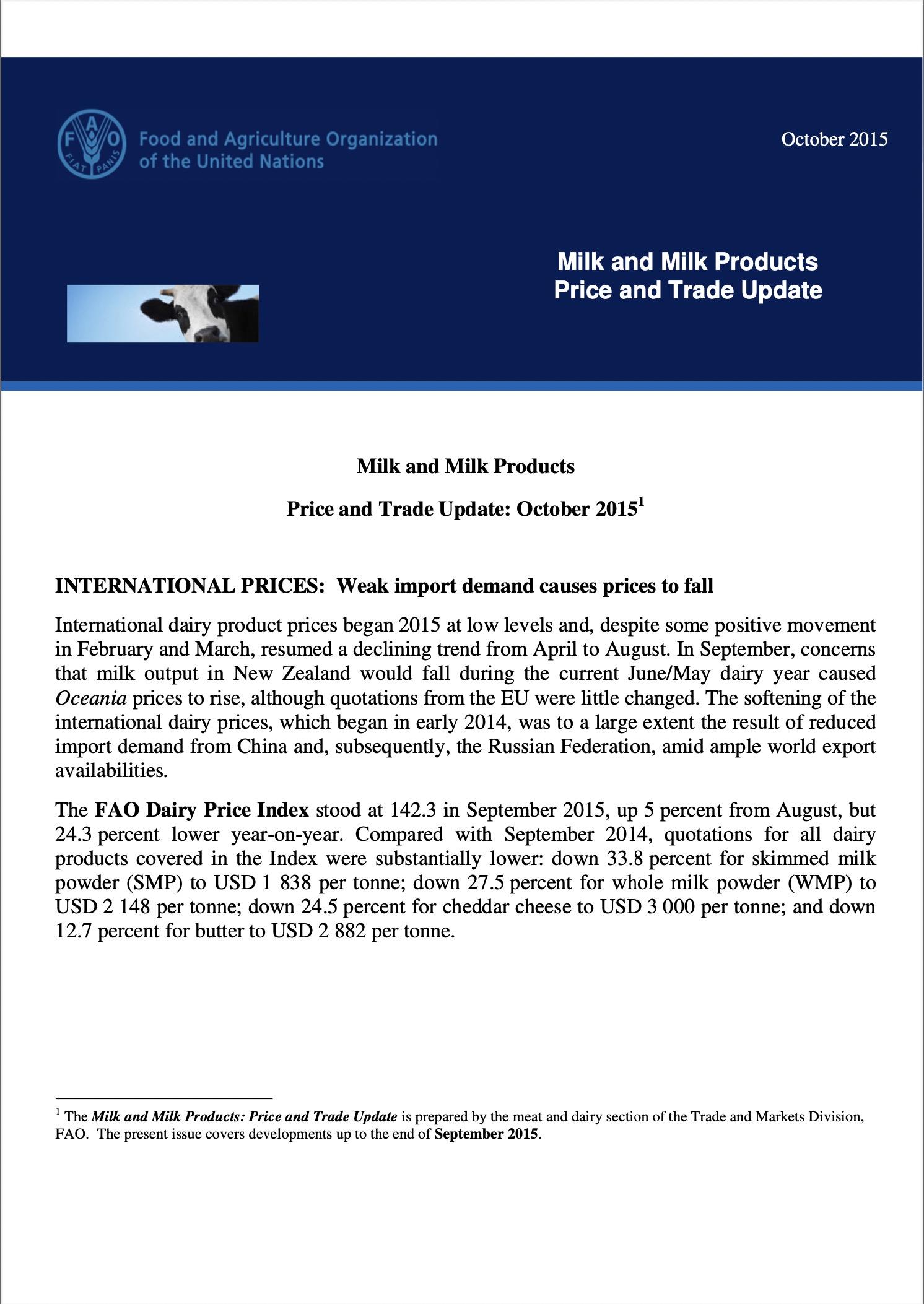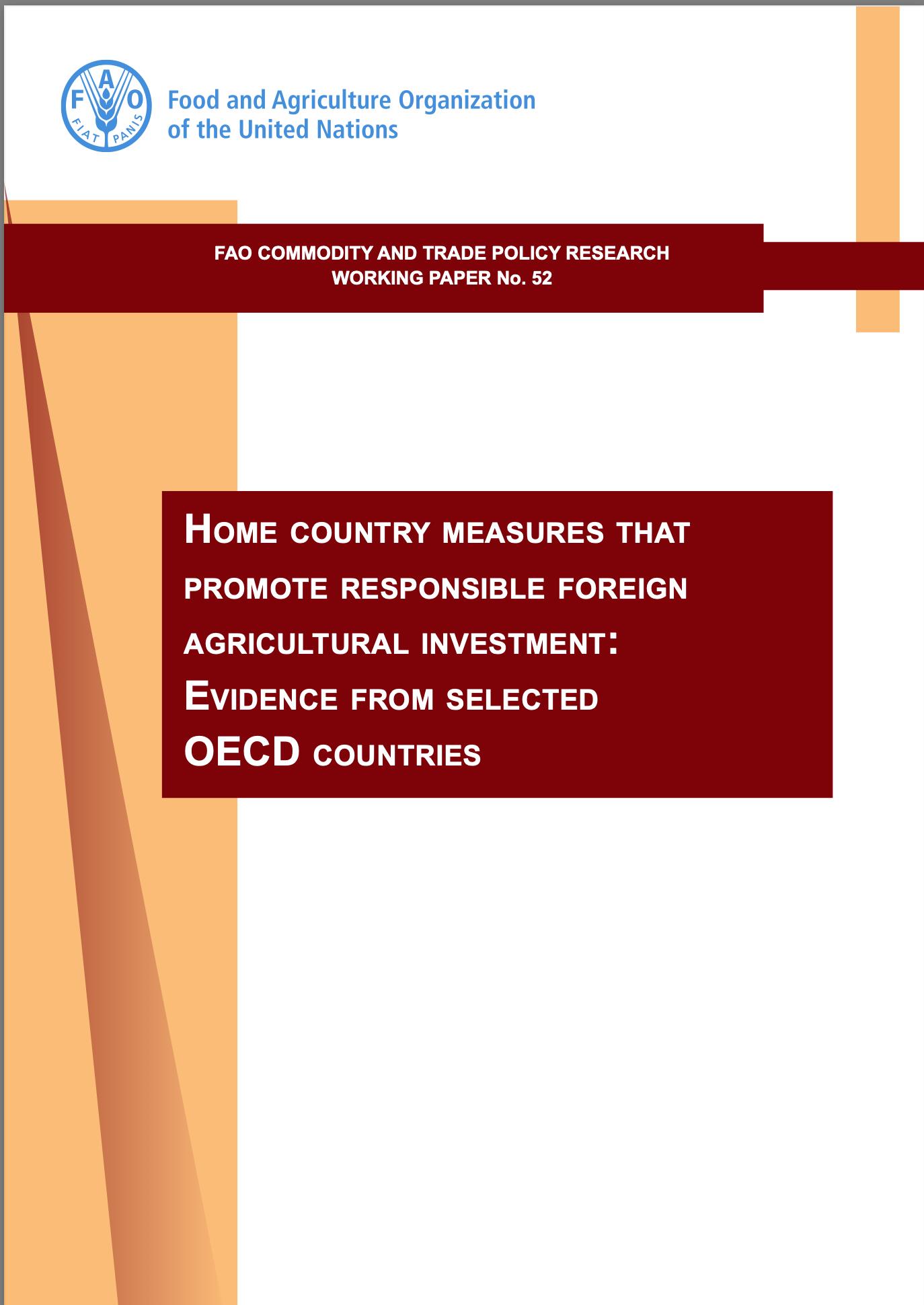
Home Country Measures that Promote Responsible Foreign Agricultural Investment: Evidence from Selected OECD Countries.
01/01/2016
This paper summarizes the good practices by nine selected OECD countries that seek to promote responsible foreign investment in developing country agriculture, primarily by investors in their territory or jurisdiction. The study provides examples of the increasing trend of home countries in establishing binding legal norms and other mechanisms as safeguards that are relevant for agricultural investment. It finds that States apply some specific provisions to hold private corporate actors investin g in agriculture abroad accountable, for example in regard to bribery of foreign public officials. Investment home countries are also increasingly using safeguards relevant for agricultural investment for companies that are controlled by the State or seek its support. Furthermore, Public-Private Partnerships are increasingly used in development assistance projects as a means to promote responsible agricultural investment. In these cases, the safeguards usually imply the use of negotiated and app roved instruments such as the Voluntary Guidelines on the Responsible Governance of Tenure of Land, Fisheries and Forests in the Context of National Food Security (VGGT). The Principles for Responsible Investment in Agriculture and Food Systems (CFS-RAI), endorsed in 2014 by the Committee on World Food Security (CFS), will possibly become a major guidance instrument, given recent declarations by the G7 and G20.
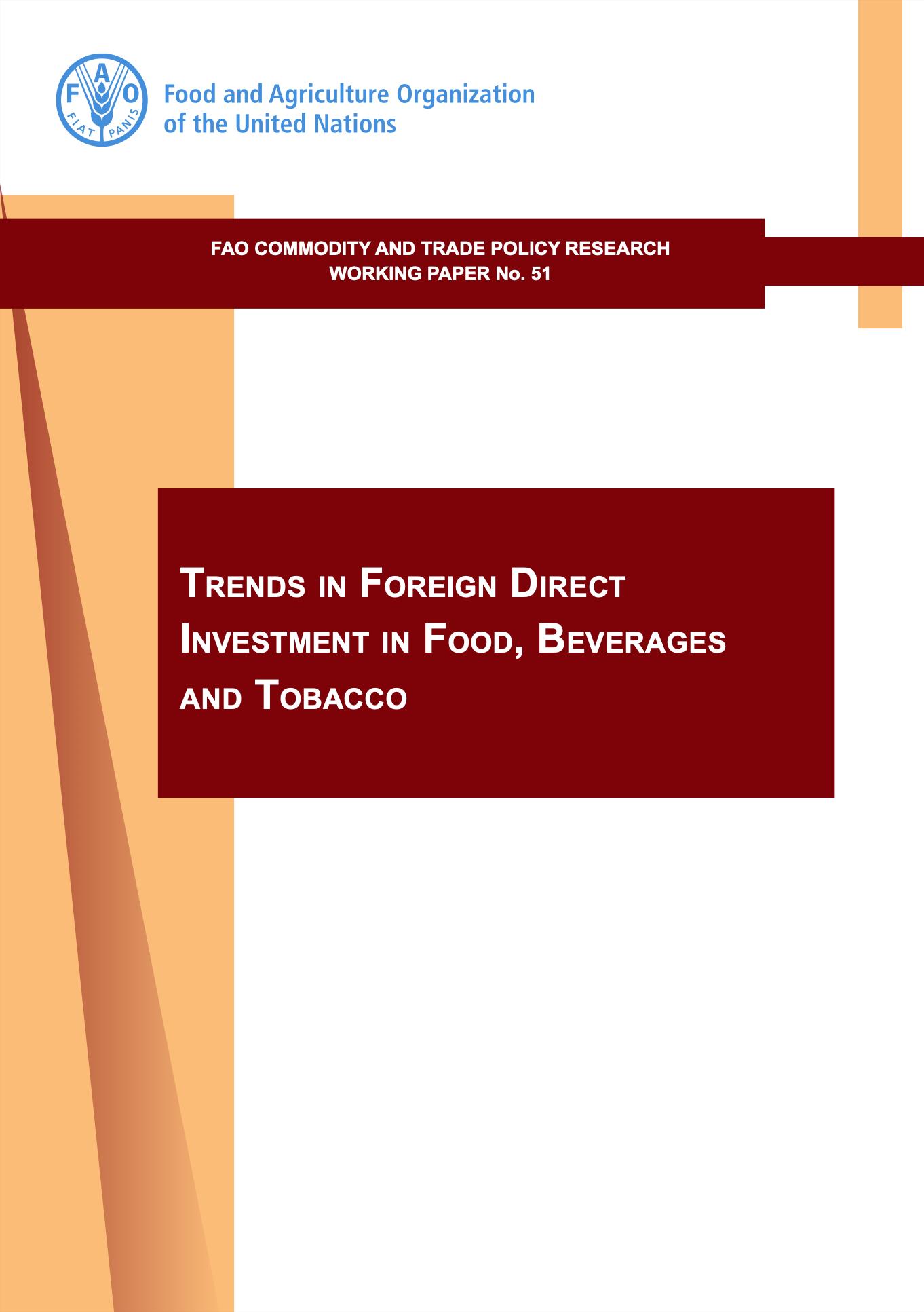
Trends in Foreign Direct Investment in Food, Beverages and Tobacco
01/01/2016
This paper analyses foreign direct investment (FDI) flows in food, beverages and tobacco, including primary agriculture and retail, from 2003 to 2014. It provides information on global, regional and - where possible - national trends in FDI flows in food, beverages and tobacco. When data are available, this study also provides more detailed insights into particular qualitative traits of FDI flows, such as whether FDI seems to be market- or resource-seeking, or in how far changes in sub-sector-sp ecific investment could be linked to changes in consumer demand. Thus it contributes to the ongoing global debate on the relevance and characteristics of FDI in developing country agriculture.
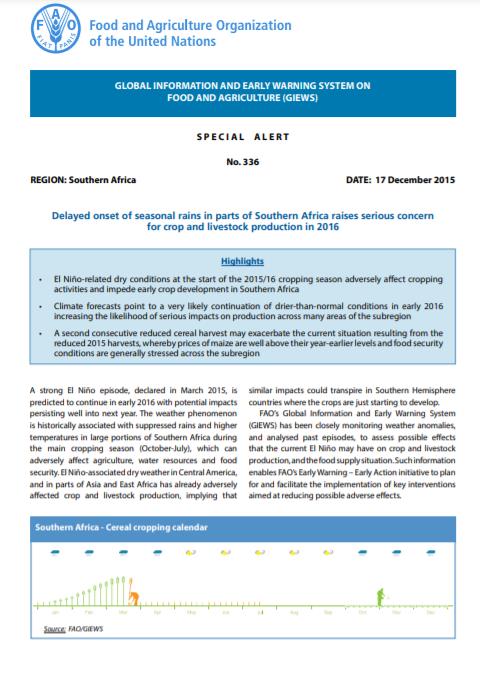
GIEWS Special Alert No. 336 - Southern Africa, 17 December 2015
17/12/2015
Climate forecasts point to a very likely continuation of drier-than-normal conditions in early 2016 increasing the likelihood of serious impacts on production across many areas of the subregion.
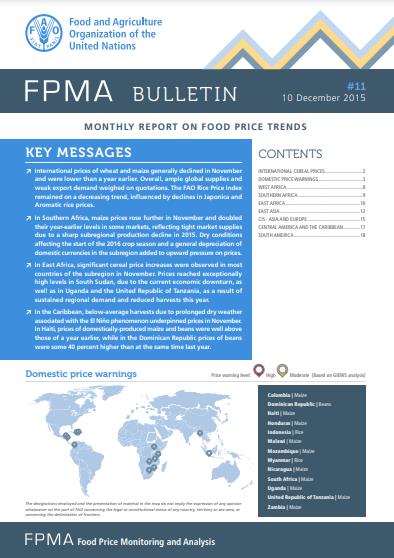
Food Price Monitoring and Analysis (FPMA) Bulletin #11, 10 December 2015
10/12/2015
International prices of wheat and maize generally declined in November and were lower than a year earlier. Overall, ample global supplies and weak export demand weighed on quotations. The FAO Rice Price Index remained on a decreasing trend, influenced by declines in Japonica and Aromatic rice prices. In Southern Africa, maize prices rose further in November and doubled their year-earlier levels in some markets, reflecting tight market supplies due to a sharp subregional production decline in 2015. Dry conditions affecting the start of the 2016 crop season and a general depreciation of domestic currencies in the subregion added to upward pressure on prices. In East Africa, significant cereal price increases were observed in most countries of the subregion in November. Prices reached exceptionally high levels in South Sudan, due to the current economic downturn, as well as in Uganda and the United Republic of Tanzania, as a result of sustained regional demand and reduced harvests this year. In the Caribbean, below-average harvests due to prolonged dry weather associated with the El Niño phenomenon underpinned prices in November. In Haiti, prices of domestically-produced maize and beans were well above those of a year earlier, while in the Dominican Republic prices of beans were some 40 percent higher than at the same time last year.
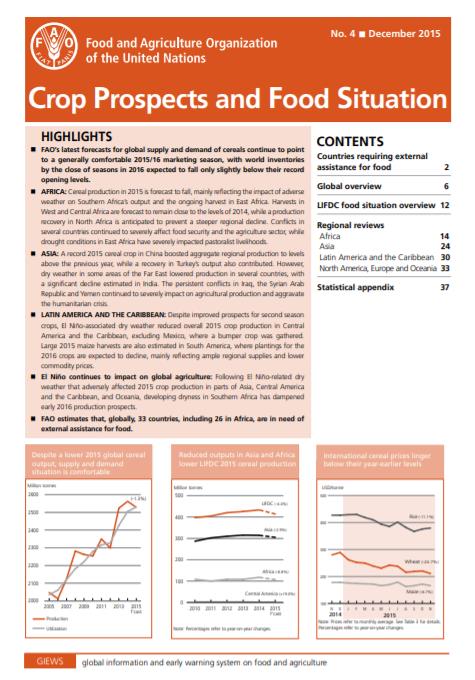
Crop Prospects and Food Situation - Quarterly Global Report, No. 4, December 2015
03/12/2015
FAO’s latest forecasts for global supply and demand of cereals continue to point to a generally comfortable 2015/16 marketing season, with world inventories by the close of seasons in 2016 expected to fall only slightly below their record opening levels. AFRICA: Cereal production in 2015 is forecast to fall, mainly reflecting the impact of adverse weather on Southern Africa’s output and the ongoing harvest in East Africa.
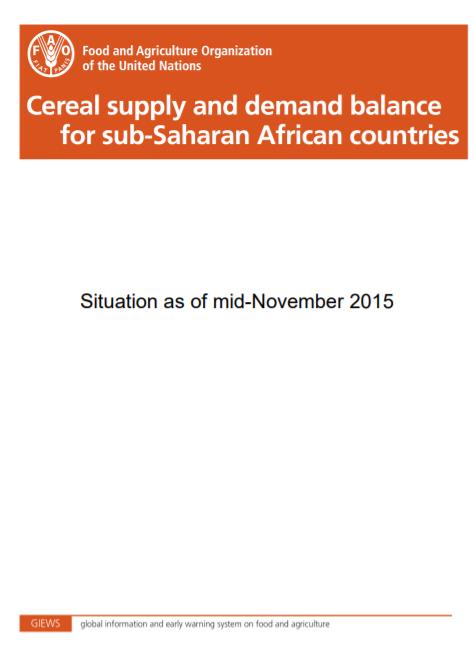
Cereal supply and demand balances for sub-Saharan African countries No.4, November 2015
19/11/2015
The FAO/GIEWS Country Cereal Balance System (CCBS) is a database of annual supply and utilization balances for main cereals, covering all countries of the world. It has been maintained by FAO/GIEWS since 1980 and is updated on a continual basis. This statistical report, which is a subset of CCBS data, presents the current-year cereal supply and demand balances for all sub-Saharan African countries, highlighting cereal import and food aid requirements of each country. This report is complement ary to the FAO/GIEWS report Crop Prospects and Food Situation and is published four times a year, with the same schedule.
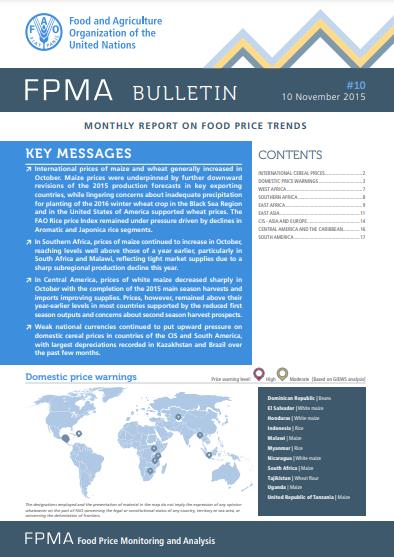
Food Price Monitoring and Analysis (FPMA) Bulletin #10, 10 November 2015
10/11/2015
International prices of maize and wheat generally increased in October. Maize prices were underpinned by further downward revisions of the 2015 production forecasts in key exporting countries, while lingering concerns about inadequate precipitation for planting of the 2016 winter wheat crop in the Black Sea Region and in the United States of America supported wheat prices. The FAO Rice price Index remained under pressure driven by declines in Aromatic and Japonica rice segments. In Southern Africa, prices of maize continued to increase in October, reaching levels well above those of a year earlier, particularly in South Africa and Malawi, reflecting tight market supplies due to a sharp subregional production decline this year. In Central America, prices of white maize decreased sharply in October with the completion of the 2015 main season harvests and imports improving supplies. Prices, however, remained above their year-earlier levels in most countries supported by the reduced first season outputs and concerns about second season harvest prospects. Weak national currencies continued to put upward pressure on domestic cereal prices in countries of the CIS and South America, with largest depreciations recorded in Kazakhstan and Brazil over the past few months.
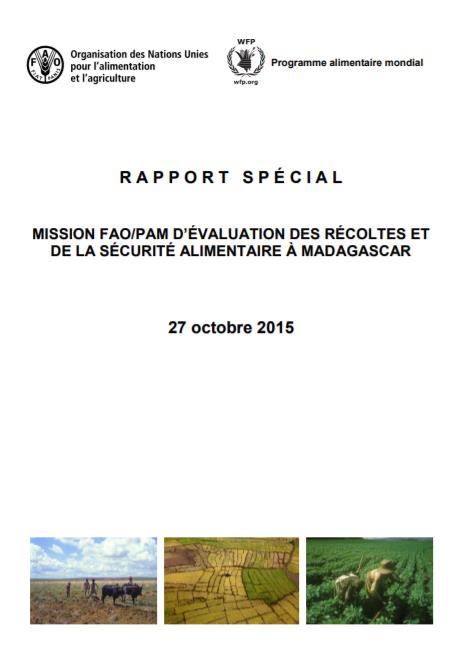
Rapport Spécial - Mission FAO/PAM d'évaluation des récoltes et de la sécurité alimentaire à Madagascar - 27 octobre 2015
27/10/2015
La grande saison de la campagne agricole 2014/15 (octobre-juin) a été durement affectée par des tempêtes tropicales Chedza et Fundi ainsi que des inondations causées par le passage des zones de convergence intertropicale qui se sont abattues sur le pays en janvier et février 2015, précédées en début de saison (octobre-décembre 2014) par un déficit de précipitations dans la plupart des régions qui ont également une sécheresse intense à partir d’avril 2015. Face à cette situation, le Gouvernement Malagasy a demandé une mission conjointe FAO/PAM d'évaluation des récoltes et de la sécurité alimentaire qui a reçu le soutien technique et logistique de la Direction de la statistique agricole, de la planification et du suivi-évaluation (DSAPSE) au sein du Ministère de l'Agriculture. La Mission avait pour mandat de recenser et d'évaluer les facteurs ayant eu une incidence sur la campagne agricole 2014/15 et d'établir une estimation de la production céréalière intérieure ainsi que d'évaluer la s ituation globale de la sécurité alimentaire. Les enquêtes ont été menées par 15 équipes dans les 22 régions du 2 juillet au 8 août 2015, utilisant des questionnaires pourtant sur les facteurs ayant influer sur la production agricole en 2014/15: conditions climatiques, ennemis et maladies des plantes, disponibilité des intrants production alimentaire, situation de l’élevage et de la pêche, marchés et prix, stocks alimentaires et situation nutritionnelle des ménages. Au total 2,448 ménages ont ét é enquêtés, répartis sur 50 districts, 150 communes et 204 fokontany (villages). La Mission a en outre rencontré des personnes clés du secteur agricole (agriculteurs, pêcheurs et agronomes) et tenu des réunions avec du personnel des Offices régionaux de nutrition (ORN).
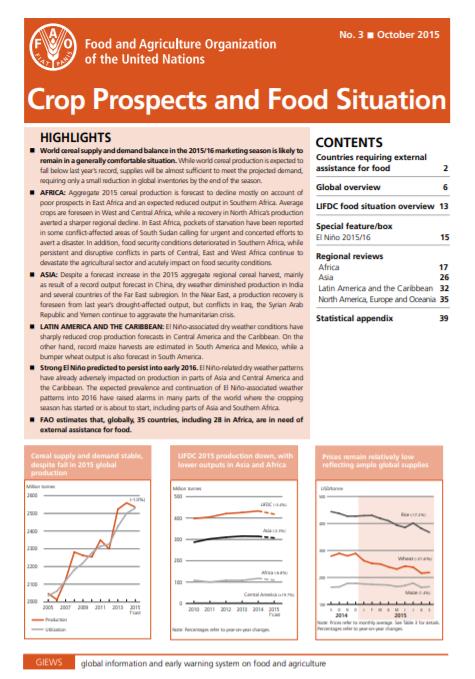
Crop Prospects and Food Situation #3, October 2015
13/10/2015
World cereal supply and demand balance in the 2015/16 marketing season is likely to remain in a generally comfortable situation. While world cereal production is expected to fall below last year’s record, supplies will be almost sufficient to meet the projected demand, requiring only a small reduction in global inventories by the end of the season. AFRICA: Aggregate 2015 cereal production is forecast to decline mostly on account of poor prospects in East Africa and an expected reduced output i n Southern Africa. Average crops are foreseen in West and Central Africa, while a recovery in North Africa’s production averted a sharper regional decline. In East Africa, pockets of starvation have been reported in some conflict-affected areas of South Sudan calling for urgent and concerted efforts to avert a disaster. In addition, food security conditions deteriorated in Southern Africa, while persistent and disruptive conflicts in parts of Central, East and West Africa continue to devastate t he agricultural sector and acutely impact on food security conditions. ASIA: Despite a forecast increase in the 2015 aggregate regional cereal harvest, mainly as result of a record output forecast in China, dry weather diminished production in India and several countries of the Far East subregion. In the Near East, a production recovery is foreseen from last year’s drought-affected output, but conflicts in Iraq, the Syrian Arab Republic and Yemen continue to aggravate the humanitarian crisis. LATIN AMERICA AND THE CARIBBEAN: El Niño-associated dry weather conditions have sharply reduced crop production forecasts in Central America and the Caribbean. On the other hand, record maize harvests are estimated in South America and Mexico, while a bumper wheat output is also forecast in South America. Strong El Niño predicted to persist into early 2016. El Niño-related dry weather patterns have already adversely impacted on production in parts of Asia and Central America and the Caribbe an. The expected prevalence and continuation of El Niño-associated weather patterns into 2016 have raised alarms in many parts of the world where the cropping season has started or is about to start, including parts of Asia and Southern Africa. FAO estimates that, globally, 35 countries, including 28 in Africa, are in need of external assistance for food.
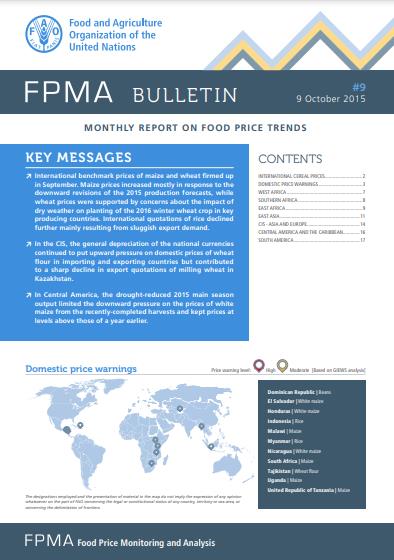
Food Price Monitoring and Analysis (FPMA) Bulletin #9, 9 October 2015
09/10/2015
International benchmark prices of maize and wheat firmed up in September. Maize prices increased mostly in response to the downward revisions of the 2015 production forecasts, while wheat prices were supported by concerns about the impact of dry weather on planting of the 2016 winter wheat crop in key producing countries. International quotations of rice declined further mainly resulting from sluggish export demand. In the CIS, the general depreciation of the national currencies continued to put upward pressure on domestic prices of wheat flour in importing and exporting countries but contributed to a sharp decline in export quotations of milling wheat in Kazakhstan. In Central America, the drought-reduced 2015 main season output limited the downward pressure on the prices of white maize from the recently-completed harvests and kept prices at levels above those of a year earlier.
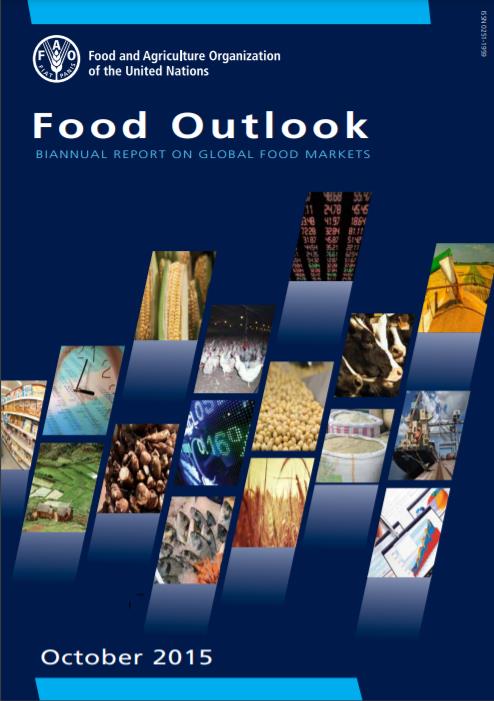
Food Outlook - October 2015
01/10/2015
Global supplies and a strong US dollar are keeping international food prices under downward pressure. The outlook for the coming season is unlikely to diverge much from the current situation, but currency movements and macroeconomic developments may have important implications for markets gain in 2015/16. Against this backdrop, the world food import bill is forecast to reach a five-year low in 2015.
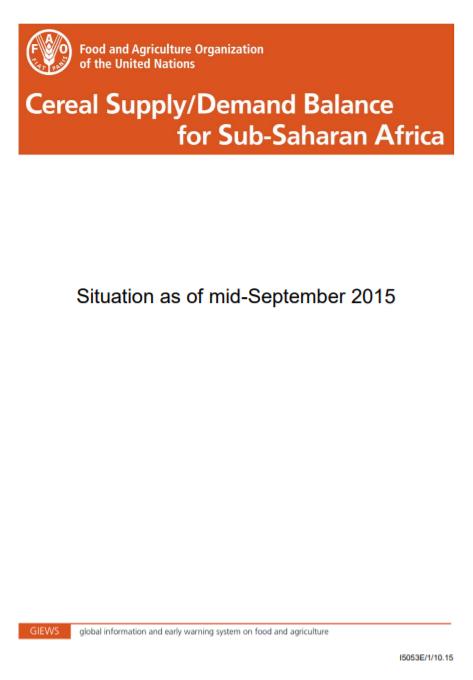
Cereal supply and demand balances for sub-Saharan African countries - No.3, September 2015
24/09/2015
The FAO/GIEWS Country Cereal Balance System (CCBS) is a database of annual supply and utilization balances for main cereals, covering all countries of the world. It has been maintained by FAO/GIEWS since 1980 and is updated on a continual basis. This statistical report, which is a subset of CCBS data, presents the current-year cereal supply and demand balances for all sub-Saharan African countries, highlighting cereal import and food aid requirements of each country. This report is complement ary to the FAO/GIEWS report Crop Prospects and Food Situation and is published four times a year, with the same schedule.

GIEWS Update - Central America, 14 September 2015
14/09/2015
Prolonged dry weather associated with the current El Niño event reduces the 2015 output of the main season crops. Aggregate 2015 maize production of the subregion’s four major producing countries is tentatively forecast by FAO to fall 8 percent from the previous year’s already reduced level, but sharper declines are expected in most-affected El Salvador and Honduras. Imports of maize in the 2015/16 marketing year (September/August) are set to increase substantially in the subregion.
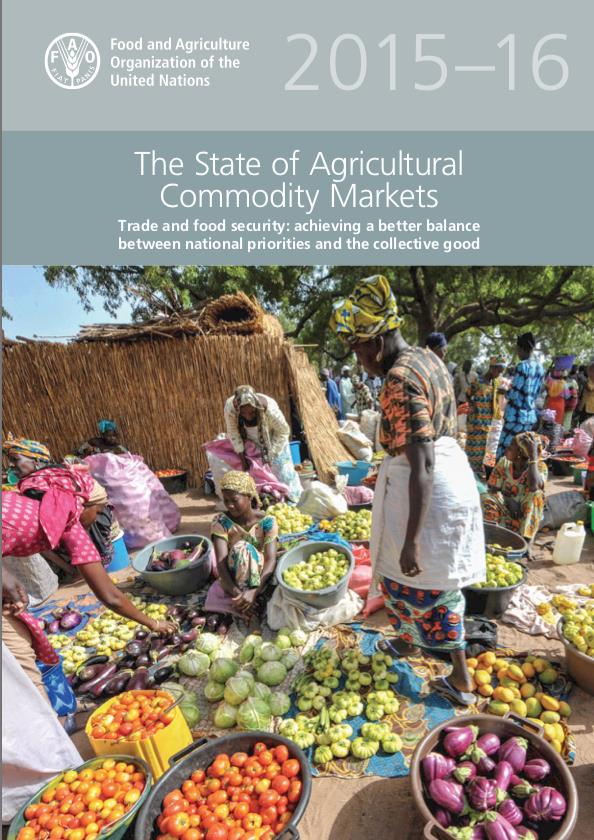
The State of Agricultural Commodity Markets 2015–16
13/09/2015
Global trade in agricultural and food products has grown rapidly in recent decades, with countries becoming more engaged in this trade, whether as exporters or importers. This trend is expected to continue over the coming decades. As a consequence, trade will play an increasingly important role in influencing the extent and nature of food security across all regions of the globe.
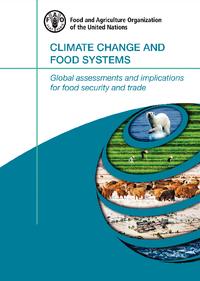
Climate Change and Food Systems
13/09/2015
This book collects the findings of a group of scientists and economists who have taken stock of climate change impacts on food and agriculture at global and regional levels over the past two decades. The evidence presented describes how global warming will impact where and how food is produced and discusses the significant consequences for food security, health and nutrition, water scarcity and climate adaptation. The book also highlights the implications for global food trade. The evidence pres ented in the book is presented in a way that is widely accessible to policy decision makers and practitioners and makes a distinct contribution towards a greater science-policy interchange. Put together, the different analyses in the book paint a comprehensive perspective linking climate change to food, nutrition, water, and trade along with suggested policy responses.
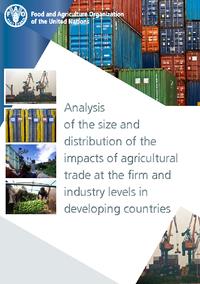
Analysis of the size and distribution of the impacts of agricultural trade at the firm and industry levels in developing countries
13/09/2015
The size and distribution of the impacts of agricultural trade matter to traders and, more important, to upstream links, including farmers and workers whose income depends on agricultural trade revenues. Because it is generally firms, not countries, that practice trade, the size and distribution of the impacts of agricultural trade in developing countries are better examined at the firm and industry level. The main purpose of the studies compiled in this report was to analyse the size and distri bution of trade impacts among heterogeneous agro-trading firms in developing countries, with special attention given to the role of the organization and behaviour of these firms. The studies included reviews of theories and evidence regarding trade impacts at the firm and industry level, as well as four case studies examining the size and distribution of trade impacts for selected agroindustries. The aim was to provide suggestions for targeted policies and efforts to enhance trade benefits among firms and input owners (farmers and workers) in upstream links.

